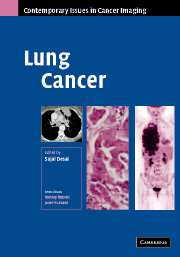Book contents
- Frontmatter
- Contents
- Contributors
- Series Foreword
- Introduction
- 1 Clinical Considerations in Lung Cancer
- 2 Pathology of Lung Cancer
- 3 Imaging of Lung Cancer
- 4 Screening for Lung Cancer
- 5 Staging of Lung Cancer
- 6 Positron Emmision Tomography in Lung Cancer
- 7 Contemporary Issues in the Systemic Treatment of Lung Cancer
- 8 Radiotherapy in Lung Cancer
- 9 Surgery for Lung Cancer
- Index
- Plate Section
- References
2 - Pathology of Lung Cancer
Published online by Cambridge University Press: 12 August 2009
- Frontmatter
- Contents
- Contributors
- Series Foreword
- Introduction
- 1 Clinical Considerations in Lung Cancer
- 2 Pathology of Lung Cancer
- 3 Imaging of Lung Cancer
- 4 Screening for Lung Cancer
- 5 Staging of Lung Cancer
- 6 Positron Emmision Tomography in Lung Cancer
- 7 Contemporary Issues in the Systemic Treatment of Lung Cancer
- 8 Radiotherapy in Lung Cancer
- 9 Surgery for Lung Cancer
- Index
- Plate Section
- References
Summary
Introduction
Lung cancer remains one of the most common cancers, accounting for 12.6% of all new cancers and just under 20% of all cancer deaths. It is widely accepted that the incidence of lung cancer is closely associated with population-related smoking behaviour; the relative risk for smokers, as compared to non-smokers, is of the order of 8–15-fold for men and 3–10-fold for women dependent on factors such as the average cigarette consumption, duration of smoking, age at which the subject starts or the time since quitting, type of tobacco and the pattern of inhalation.
Traditionally, squamous cell carcinoma has the strongest association with tobacco smoking, followed by small cell carcinoma and adenocarcinoma. However, the association with adenocarcinoma has become stronger over time and this histological subtype has become the most common type in many western countries. There are also recognized occupational exposures to carcinogens known to be associated with lung cancer, the most important being asbestos, crystalline silica, radon, mixtures of polycyclic aromatic hydrocarbons and heavy metals. Welding and painting are consistently associated with an increased risk of lung cancer, but the causative agents are still unknown.
Almost all lung malignancies are carcinomas with other histological types accounting for less than 1%. In a published series on cancer incidence, small cell carcinomas comprised approximately 20% of cases and large cell carcinoma around 9%.
- Type
- Chapter
- Information
- Lung Cancer , pp. 12 - 26Publisher: Cambridge University PressPrint publication year: 2006
References
- 1
- Cited by



